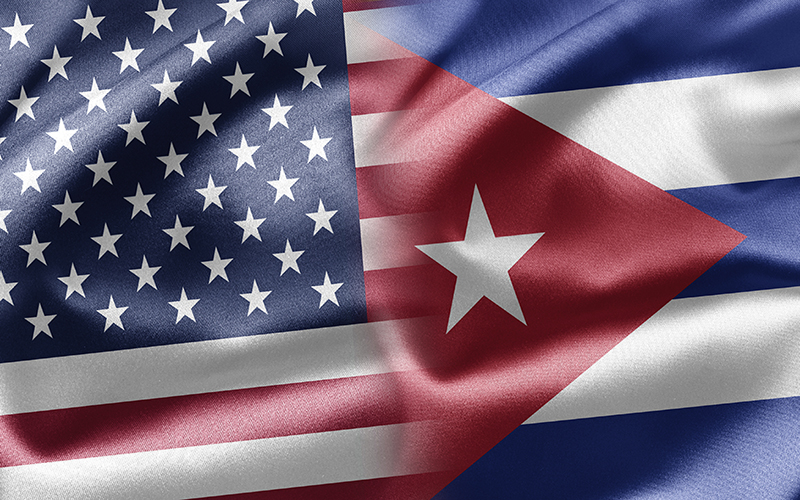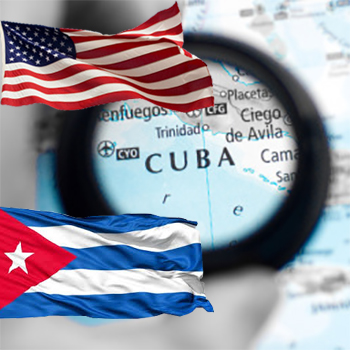What Free Trade Could Mean For The United States and Cuba

Even though the U.S. embargo on Cuba has been in place for half of Cuba’s independent history, U.S. businesses are keeping an eye on new opportunities in Cuba.
Launched with the Eisenhower administration’s cancellation of Cuban sugar quotas in the summer of 1960, the U.S. embargo on Cuba has been ratcheted up over five decades to include nearly full bans on trade, investment, travel, and small financial transfers.
Having lasted for 64 of the 112 years since Cuba’s independence in 1902, the embargo policy is now older than 9 million of Cuba’s 11.3 million people.
The Obama administration’s December shift in course involves some scaling back of sanctions – credit card and financial links, telecom business, travel – and, on the grounds that “American businesses should not be put at a disadvantage, and increased commerce is good for Americans and for Cubans,” a call for Congress to consider “an honest and serious debate about lifting the embargo.”
UPDATE: Obama measures on Cuba trade, travel poke new holes in embargo
What would this mean? The consequences for politics within Cuba, family relationships, and so forth are of course unknowable. But in the limited world of trade flows, here are three non-scientific measuring sticks for the potential scale:

1. Top estimate, from comparisons with the pre-Castro era: In 1955, the $455 million worth of goods Cubans bought from the United States – including some cars still running today – accounted for 3 percent of America’s $15.5 billion total exports.
This placed Cuba 8th as an American export market, below Canada, the U.K., Mexico, Japan, Germany, Venezuela, and the Netherlands, but above France, Italy, Brazil, and Korea.
Cubans, meanwhile, sold $422 million in goods to the U.S, out of $11.4 billion in total imports. (Mostly sweets – Cuba supplied about 2.9 million tons a year in the 1950s, a third of all the sugar Americans were using at the time – plus some cigars and metal ores.) Cuba ranked 7th in the world as an exporter to the U.S., outdoing Germany’s $366 million and Mexico’s $397 million, and just barely below Japan’s $432 million.
Conclusion: Given some noticeable changes in the trading world since the 1950s – end of the embargo on China, creation of the European Union, etc. – Cuba probably isn’t likely to regain its 1950s-era share of U.S. commerce at roughly 3 percent of U.S. imports and exports.
If it did, though, with the annual U.S. merchandise trade levels now about $3 trillion, two-way goods trade would be $100 billion or so, probably with some U.S. surplus. This would place Cuba in the neighborhood of the United Kingdom and Korea, and a bit above Saudi Arabia and Brazil.
2. Low estimate, from current levels of Cuban trade and analogies with other Caribbean islands: Cuban imports in 2013 were about $15.8 billion, and exports $5.8 billion. The $21.6 billion total is standard for the larger Caribbean islands: the Dominican Republic is at $27 billion, Trinidad $25 billion, Jamaica $8 billion, and Haiti $4.6 billion. The U.S. supplies about 28 percent of Trinidadian imports, 35 percent for Haiti, and 40 percent for Jamaica, Haiti, and the Dominican Republic.
Conclusion: At current levels of Cuban trade, and assuming the U.S. share might be similar to the shares for Jamaica, Trinidad, Haiti, and the D.R., U.S. exports to Cuba might be $6 billion or so, and imports $4 billion.
3. Medium estimate, using recent evidence from agricultural trade: In 2001, Congress poked a small hole in the embargo by legalizing sales of food and medicine. Farm exports to Cuba rose from minimal figures to a $685 million peak in 2007 (setting, for whatever it’s worth, a nominal-dollar record for total U.S. exports to Cuba.) The Bush administration however did not welcome the idea, and tried with some success to frustrate it by:
- refusing to permit financing of exports
- barring ships carrying goods to Cuba from leaving port without payment in advance.
This cut exports to $350 million a year after 2008, about the same as farm sales to Jamaica and Haiti, and a bit above the sales to Nicaragua. The U.S. International Trade Commission, looking at these numbers in 2090, guessed at a likely potential U.S. farm export total of $1.2 billion.
Conclusion: Agriculture is about 8 percent of all U.S. exports worldwide. If this ratio holds for Cuba, with farm goods at $1.2 billion, total goods exports would be around $15 billion, comparable with Chile, Israel, and Italy and above Russia.
Note: The U.K. would rank much higher, about $210 billion, with services trade counted in. We haven’t included services in this fact, not out of laziness or a desire to down-rate Britain, but to preserve like-to-like comparisons – no services trade by country figures, for Cuba or otherwise, are available for the 1950s.
Related: Cuba Gains Symbolic Win, But Don’t Expect Supply Chains to Follow

Article Topics
Crane Worldwide Logistics News & Resources
Cuba Gains Symbolic Win, But Don’t Expect Supply Chains to Follow Cuban Cigars Allowed in the US After Ban is Lifted Optimism, And Questions, About U.S.-Cuba Shipping What Free Trade Could Mean For The United States and CubaLatest in Supply Chain
Microsoft Unveils New AI Innovations For Warehouses Let’s Spend Five Minutes Talking About ... Malaysia Baltimore Bridge Collapse: Impact on Freight Navigating TIm Cook Says Apple Plans to Increase Investments in Vietnam Amazon Logistics’ Growth Shakes Up Shipping Industry in 2023 Spotlight Startup: Cart.com is Reimagining Logistics Walmart and Swisslog Expand Partnership with New Texas Facility More Supply Chain












